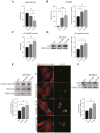Murine Myoblasts Exposed to SYUIQ-5 Acquire Senescence Phenotype and Differentiate into Sarcopenic-Like Myotubes, an In Vitro Study
- PMID: 38267369
- PMCID: PMC10924451
- DOI: 10.1093/gerona/glae022
Murine Myoblasts Exposed to SYUIQ-5 Acquire Senescence Phenotype and Differentiate into Sarcopenic-Like Myotubes, an In Vitro Study
Abstract
The musculoskeletal system is one of the most affected organs by aging that correlates well with an accumulation of senescent cells as for other multiple age-related pathologies. The molecular mechanisms underpinning muscle impairment because of senescent cells are still elusive. The availability of in vitro model of skeletal muscle senescence is limited and restricted to a small panel of phenotypic features of these senescent cells in vivo. Here, we developed a new in vitro model of senescent C2C12 mouse myoblasts that, when subjected to differentiation, the resulting myotubes showed sarcopenic features. To induce senescence, we used SYUIQ-5, a quindoline derivative molecule inhibitor of telomerase activity, leading to the expression of several senescent hallmarks in treated myoblasts. They had increased levels of p21 protein accordingly with the observed cell cycle arrest. Furthermore, they had enhanced SA-βgalactosidase enzyme activity and phosphorylation of p53 and histone H2AX. SYUIQ-5 senescent myoblasts had impaired differentiation potential and the resulting myotubes showed increased levels of ATROGIN-1 and MURF1, ubiquitin ligases components responsible for protein degradation, and decreased mitochondria content, typical features of sarcopenic muscles. Myotubes differentiated from senescent myoblasts cultures release increased levels of MYOSTATIN that could affect skeletal muscle cell growth. Overall, our data suggest that a greater burden of senescent muscle cells could contribute to sarcopenia. This study presents a well-defined in vitro model of muscle cell senescence useful for deeper investigation in the aging research field to discover new putative therapeutic targets and senescence biomarkers associated with the aged musculoskeletal system.
Keywords: In vitro model; SYUIQ-5; Sarcopenic myotubes; Senescence; Senescent myoblasts.
© The Author(s) 2024. Published by Oxford University Press on behalf of The Gerontological Society of America.
Conflict of interest statement
None.
Figures






Similar articles
-
Cdkn1a silencing restores myoblast differentiation by inducing selective apoptosis in senescent cells.Cell Mol Biol Lett. 2025 Apr 30;30(1):53. doi: 10.1186/s11658-025-00731-9. Cell Mol Biol Lett. 2025. PMID: 40307745 Free PMC article.
-
7β-Hydroxycholesterol and 7-ketocholesterol: New oxidative stress biomarkers of sarcopenia inducing cytotoxic effects on myoblasts and myotubes.J Steroid Biochem Mol Biol. 2023 Sep;232:106345. doi: 10.1016/j.jsbmb.2023.106345. Epub 2023 Jun 5. J Steroid Biochem Mol Biol. 2023. PMID: 37286110
-
Senescent myoblasts exhibit an altered exometabolome that is linked to senescence-associated secretory phenotype signaling.Am J Physiol Cell Physiol. 2025 Feb 1;328(2):C440-C451. doi: 10.1152/ajpcell.00880.2024. Epub 2024 Dec 26. Am J Physiol Cell Physiol. 2025. PMID: 39726265
-
Cellular Senescence in Diabetes Mellitus: Distinct Senotherapeutic Strategies for Adipose Tissue and Pancreatic β Cells.Front Endocrinol (Lausanne). 2022 Mar 31;13:869414. doi: 10.3389/fendo.2022.869414. eCollection 2022. Front Endocrinol (Lausanne). 2022. PMID: 35432205 Free PMC article. Review.
-
Mitochondria and cellular senescence: Implications for musculoskeletal ageing.Free Radic Biol Med. 2019 Feb 20;132:3-10. doi: 10.1016/j.freeradbiomed.2018.10.417. Epub 2018 Oct 15. Free Radic Biol Med. 2019. PMID: 30336251 Review.
Cited by
-
Epigenetics of Skeletal Muscle Atrophy.Int J Mol Sci. 2024 Jul 31;25(15):8362. doi: 10.3390/ijms25158362. Int J Mol Sci. 2024. PMID: 39125931 Free PMC article. Review.
References
Publication types
MeSH terms
Substances
Grants and funding
LinkOut - more resources
Full Text Sources
Research Materials
Miscellaneous

